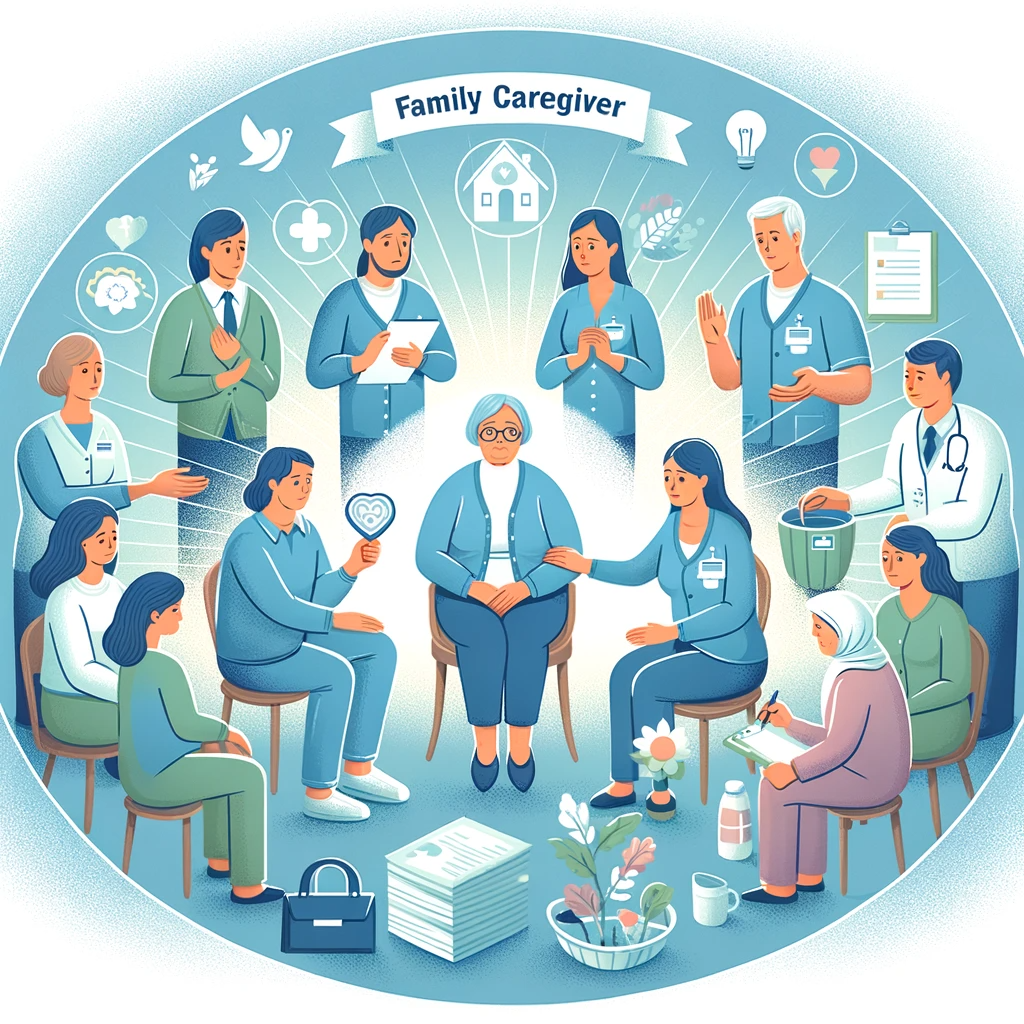Showing Gratitude to Family Caregivers and Direct Care Workers During the Holiday Season: Practical Ways to Express Thanks
This article aims to shed light on how we, as family members and society, can actively support these unsung heroes. It offers practical ways to support the caregivers

In the realm of caregiving, family caregivers and direct care workers form the essential backbone. Their tireless efforts often go unnoticed, yet they play a pivotal role in providing comfort and support to those in need. This article aims to shed light on how we, as family members and society, can actively support these unsung heroes. It also introduces a vital initiative: the caregiver relief family caregiver and direct care worker petition, advocating for a more inclusive and supportive approach to caregiving.
Family caregivers often navigate a multifaceted landscape of physical, emotional, financial, and social challenges, which can impact their overall well-being. Here's a more detailed exploration of these challenges:
Emotional and Mental Health Strain:
Family caregivers frequently experience high levels of stress, anxiety, and emotional fatigue. The constant concern for the well-being of their loved ones, coupled with the demands of caregiving, can lead to feelings of overwhelm, isolation, and in some cases, depression. Managing the emotional needs of the care recipient while neglecting their own mental health is a common challenge.

Physical Demands and Health Risks:
The physical aspect of caregiving—such as lifting, bathing, and other physical tasks—can take a toll on the caregiver's health. This physical strain can lead to chronic pain, injuries, and other health problems. Caregivers often neglect their health needs, skipping doctor appointments and not maintaining a healthy lifestyle due to their caregiving responsibilities.
Financial Burden:
Many family caregivers face financial challenges, especially if they have to reduce their work hours or leave their job entirely to provide care. The cost of medical supplies, medications, and other care-related expenses can add a significant financial strain. Moreover, the lack of compensation for their caregiving role can lead to long-term financial insecurity.
Lack of Training and Support:
Family caregivers often find themselves in this role without any formal training or preparation. They may be unsure about how to perform medical tasks or manage the complex needs of their loved ones. The lack of adequate support and resources can make caregiving even more challenging.
Balancing Caregiving with Other Responsibilities:
Juggling caregiving with other duties such as parenting, working, and managing a household can be extremely challenging. Caregivers often struggle to find a balance, leading to burnout and a feeling of being stretched too thin.

Social Isolation:
Caregiving can be an isolating experience, as caregivers may find themselves with limited time or opportunity to socialize or engage in activities they enjoy. This isolation can lead to a sense of loneliness and disconnection from others.
Guilt and Emotional Conflict:
Caregivers often experience feelings of guilt, whether it's about not doing enough, taking time for themselves, or feeling frustrated with their caregiving responsibilities. This emotional turmoil can be difficult to navigate, especially when compounded with societal expectations and personal standards.
Navigating Healthcare and Legal Systems:
Caregivers often have to advocate for their loved ones in complex healthcare and legal systems. This can include managing medical appointments, understanding treatment options, and handling legal matters related to care, which can be overwhelming without proper guidance and support.
Understanding these challenges is crucial for developing effective support systems for family caregivers. It highlights the need for comprehensive resources, respite care options, and societal recognition of the vital role these caregivers play in the healthcare system.

The Care Team Partner Approach:
A collaborative care team partner approach is crucial in caregiving. This method acknowledges that caregiving is not a solo mission but a team effort involving family caregivers, direct care workers, and other family members. It's imperative to understand that uninvolved siblings and relatives should contribute, either through hands-on care or by financially supporting respite care services. Such contributions are vital in preventing caregiver burnout and ensuring the sustainability of care.
The Care Team Partner Approach to caregiving represents a holistic and collaborative method of providing care, recognizing that effective and sustainable caregiving involves a network of individuals working together. This approach is particularly beneficial in addressing the multifaceted needs of both the care recipient and the caregiver. Here are key elements of the Care Team Partner Approach:
Inclusive Team Formation:
The care team typically includes family members, direct care workers, healthcare professionals, and sometimes friends or community members. Each member brings unique skills and perspectives, creating a well-rounded support system.
Roles and Responsibilities: In this approach, tasks and responsibilities are distributed among team members based on their abilities, availability, and relationship with the care recipient. This division of labor helps prevent caregiver burnout by ensuring no single person is overwhelmed with responsibilities.
Open Communication: Effective communication is vital. Regular meetings or updates, whether in-person or virtual, help keep everyone informed about the care recipient's condition, progress, and changing needs. It also provides a platform for caregivers to express their needs and concerns.
Integrated Care Plans: The care plan is developed collaboratively, taking into account the medical, emotional, social, and practical needs of the care recipient. This plan is regularly reviewed and adjusted as needed, with input from all team members, including the care recipient when possible.
Support for the Caregiver: Recognizing the challenges faced by primary caregivers, the care team approach emphasizes support for caregivers, including respite care, emotional support, and assistance with caregiving tasks. This ensures caregivers have time to rest and attend to their own needs.
Education and Training: Care team members, especially those without professional healthcare backgrounds, may receive training and education on caregiving techniques, basic medical care, and how to handle specific conditions or situations. This empowers them to provide better care and feel more confident in their roles.
Use of Technology and Resources: Leveraging technology, like health monitoring apps or virtual healthcare services, can enhance the care provided. Additionally, the team can access community resources such as support groups, counseling, and financial assistance programs.
Emotional and Social Support: Beyond the physical and medical aspects of care, the approach acknowledges the importance of emotional and social well-being. Activities that promote social interaction, hobbies, and personal interests are incorporated into the care plan.
Advocacy and Navigation: Navigating healthcare systems, legal matters, and insurance can be daunting. The care team approach involves members who can assist in these areas, advocating for the care recipient’s rights and ensuring they receive all necessary services and benefits.
Flexibility and Adaptability: Recognizing that situations can change quickly in caregiving, this approach is built on flexibility and adaptability, allowing the team to respond effectively to new challenges or changes in the care recipient’s condition.
The Care Team Partner Approach thus provides a comprehensive, multifaceted, and flexible framework for caregiving, significantly improving the quality of care for the recipient while also supporting the well-being of the caregiver. It fosters a sense of community and shared responsibility, which is crucial in the often challenging journey of caregiving.

Compelling Argument for Support:
The need for robust support systems for family caregivers cannot be overstated. These individuals often face immense challenges, including emotional, physical, and financial strain. Supporting them is not just a moral obligation but a necessity to maintain the health and well-being of our families and communities.
Addressing Challenges and Advocating Change:
The caregiving landscape is rife with challenges that need urgent attention and action. From inadequate resources to lack of recognition, family caregivers and direct care workers often find themselves in challenging situations. There's a pressing need for policy changes, increased support, and recognition of the invaluable role these caregivers play.
Case Study - Thanksgiving Acknowledgment:
Consider a typical family gathering, like Thanksgiving. Picture a scene where a family acknowledges the efforts of the matriarch, a dedicated family caregiver, with a heartfelt toast. While such moments are touching, they often lack the substance of tangible support. It's common for family caregivers to feel appreciated in words but left alone in their daily struggles.
Actionable Ways to Show Support for the Family Caregiver:
Provide Hands-on Assistance:
Instead of mere words of gratitude, offering practical help can make a significant difference. This might include assisting with daily caregiving tasks or taking over some responsibilities to give the caregiver a much-needed break.
Financial Contribution for Respite Care:
For those unable to provide physical assistance, contributing financially to respite care services can be immensely helpful. It allows the primary caregiver some time for themselves, which is essential for their well-being.
Embrace the Team Approach:
Encourage family members to work together, forming a care team that supports the family caregiver. This approach distributes the responsibility and ensures that the caregiver is not left to manage everything alone.
Conclusion:
Supporting family caregivers and direct care workers is a responsibility that falls on all of us. It's about turning our appreciation into action and ensuring that these vital members of our community receive the support they need and deserve. Let's move beyond words and take concrete steps to show our gratitude and support.
Help Support the Caregiver Relief Family and Direct Care Worker Petition Please sign and share
You might also like this article:





